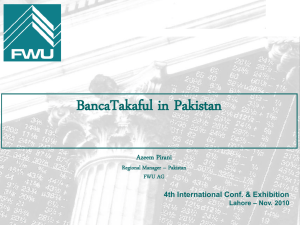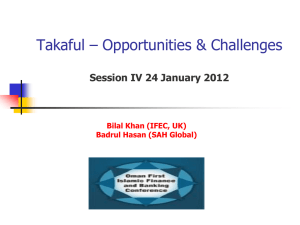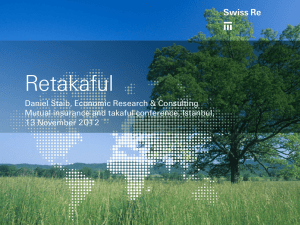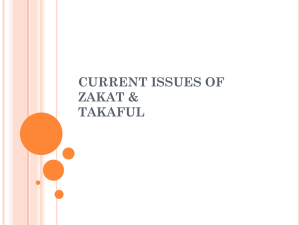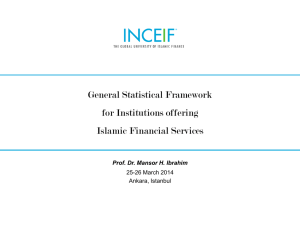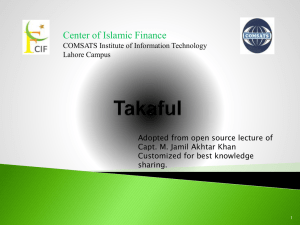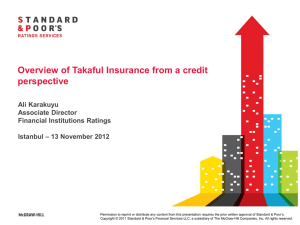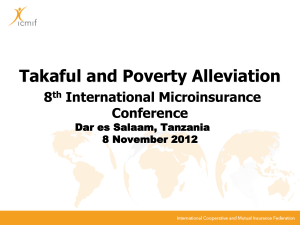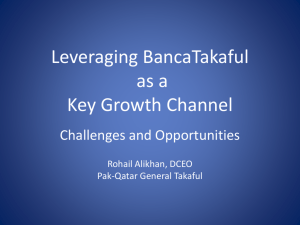Mutual Insurance and Takaful in a Changing World
advertisement
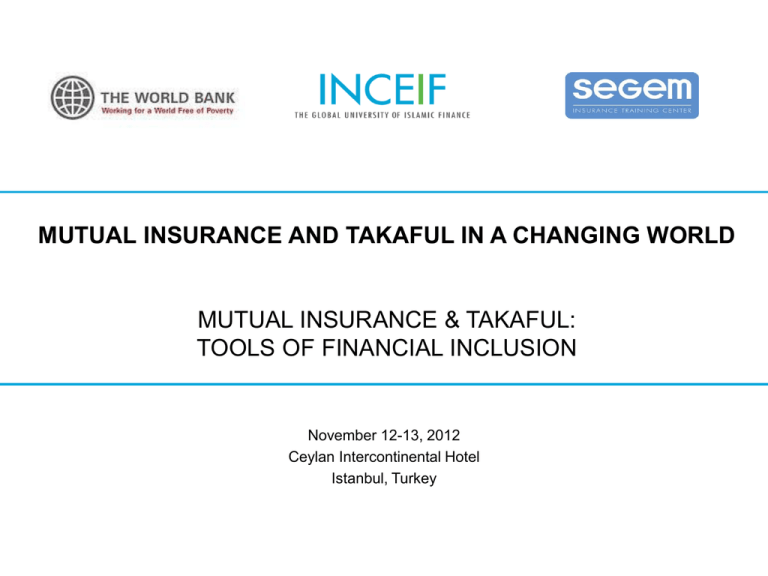
MUTUAL INSURANCE AND TAKAFUL IN A CHANGING WORLD MUTUAL INSURANCE & TAKAFUL: TOOLS OF FINANCIAL INCLUSION November 12-13, 2012 Ceylan Intercontinental Hotel Istanbul, Turkey © INCEIF 2012. TAKAFUL PRESENT STATUS Currently there are more than 250 takaful operators globally; According to the Ernst & Young World Takaful Report 2011: the takaful market was worth US$ 12 billion in 2011, an increase of 31% from US$ 9.15 billion posted in 2010; According to Milliman Global Family Takaful Report 2010: the global family takaful gross contributions in 2010 were estimated to be US$ 1.7 billion, 29% higher than in 2009; Most of the takaful business activities are al-tijari centric; © INCEIF 2012. 2 Over the last 33 years, what we see in essence is the development and growth accentuated on the commercial side of takaful, i.e. takaful al-tijari; The focus of the takaful industry is concentrated mainly on personal benefits or interests of an “exclusive club” namely the takaful participants rather than the society at large, namely the poor and the vulnerables; Muslims however, should not overlook the spirit that underlies the takaful operations that comes under the form of takaful al-ijtimai (mutual social responsibility) which includes all material and moral aspects of life that are implicit in the Maqasid al-Shariah; 3 © INCEIF 2012. Operationalizing the concept takaful al-ijtimai can take two forms namely: Through the promulgation of cash waqf; Through the introduction of microtakaful programs. As a tool of financial inclusion, a framework of a microtakaful entity is proposed. This framework is comprised of the participation of three parties namely: Participation of the government together with the cooperation from international bodies; Participation of existing takaful operators in the given country; Participation by the members of the scheme themselves. 4 © INCEIF 2012. PROPOSED FRAMEWORK OF A MICROTAKAFUL ENTITY Funds provided by Takaful Operators through the mechanism of Cash Waqf and surplus distribution Funds provided by the Government together with grants from International Funds Microtakaful Entity Benefits to be paid to the participants Subsidized Contributions made by participants of the scheme. 5 © INCEIF 2012. From the proposed framework, the fund providers are: a) Government & International Assistance: Funds can be provided by the government through An annual budget; An outright endowment; Funds can be elicited through international grants provided by the World Bank, Islamic Development Bank and other related international bodies. © INCEIF 2012. 6 b) Takaful Operators: Takaful participants from the various takaful companies can make their contribution into the microtakaful fund through the mechanism of: Cash waqf; Surplus distribution; To encourage the takaful participants to be involved in this scheme, the government should provide tax incentives; c) Microtakaful Scheme Participants: Since the participants are from the poor and the vulnerable group only a nominal contribution would be required. © INCEIF 2012. 7 SUSTAINABILITY OF THE PROPOSED FRAMEWORK For the proposed framework to be sustainable we need to be mindful of the following factors: a) The need to create and enhance a national strategy and regulatory framework so as: To avoid vague government policy direction; Not to be confronted with unclear guidelines on the implementation of the scheme; b) The need to create appropriate products which are: Tailor-fitted to the needs of participants; Affordable; Simple; Do not require cumbersome requirements. © INCEIF 2012. 8 c) The need to propagate the scheme so as increase the awareness among the potential participants; d) To be aware of the idiosyncratic risk that might appear and caused catastrophic losses; e) The number of participants in the scheme as well as the benefits offered so that the cost of administering the program can be monitored and controlled. © INCEIF 2012. 9 • Apart from the above factors we need also to address the (i) the participants’ issues (demand-side issues) and (ii) the operators’ issues (supply-side issues); i. Among the participants’ issues are: • Usability of services such as claims settlement; it need to be: • • • Flexible Convenient Reliable • The product is designed as such so as to allow participants to make frequent, low-value transactions • Through the use of technology, will enable the operators to keep transaction-size barriers to be low as possible; this could reduce cost of service delivery. © INCEIF 2012. 10 ii. Operators’ issues (Supply-side issues): • From the provider’s perspective, the key concern in managing product risks will lead to the problems of: • Information asymmetry • Adverse selection • Moral hazard • Providers is responsible to convey product features to clients in a simplistic manner, while managing the design complexities at the back-end © INCEIF 2012. 11 Thank You Prof. Dr. Kamaruddin Sharif Tel: +603 2781 4000 kamaruddin@inceif.org Email: Website: www.inceif.org © INCEIF 2012.
